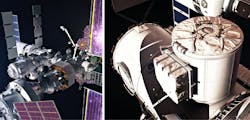NASA taps UAE to provide gateway airlock on first lunar space station
WASHINGTON - The National Aeronautics and Space Administration (NASA) needed an airlock for the Gateway lunar space station - humanity's first that will orbit the Moon. They found their solution from the United Arab Emirates' Mohammed bin Rashid Space Centre in Dubai.
The Gateway space station is built with international and commercial partners with an eye to enable technologies for NASA's future missions to the Moon, Mars, and deep space.
In a novel operational framework to extend their collaborative efforts in human spaceflight, MBRSC is set to enhance its partnership with NASA through the Gateway program. In this collaboration, MBRSC will contribute the Crew and Science Airlock module to Gateway and a designated UAE astronaut slated to embark on a future Artemis mission to the lunar space station.
MBRSC's responsibilities encompass not only the operation of the airlock but also the provision of ongoing engineering support for the entirety of the lunar space station's operational life. The primary function of the airlock is to facilitate seamless transfers of crew and scientific research between the pressurized crew modules within Gateway and the vacuum of space. These transfers are pivotal for advancing scientific exploration in the unique deep space environment and ensuring the maintenance of the Gateway.
The Gateway program, in turn, plays a critical role in enabling sustained exploration and research in deep space. It serves as a habitat for astronauts, providing a conducive environment for living and working. Furthermore, it functions as a pivotal staging point for lunar surface missions and presents opportunities for spacewalks while orbiting the Moon.
This collaborative initiative on Gateway builds upon the successful history of human spaceflight cooperation between NASA and the UAE. Notably, in 2019, Hazzaa Almansoori made history as the first Emirati astronaut to journey to space, conducting experiments and educational outreach during a mission to the International Space Station in partnership with NASA. Subsequently, in 2023, Sultan Al Neyadi, a second Emirati astronaut, participated in scientific research aboard the space station as part of NASA's SpaceX Crew-6 mission. The UAE presently has two additional astronaut candidates undergoing training at NASA's Johnson Space Center in Houston. Beyond human spaceflight, NASA and the UAE have collaborated on Mars research, human research, and analog studies, aligning with shared exploration priorities.
"As chair of the National Space Council, I have made it a priority to enhance international cooperation in space. Today's announcement and partnership between the United States and United Arab Emirates advances this important work. By combining our resources, scientific capacity, and technical skill, the U.S. and UAE will further our collective vision for space and ensure it presents extraordinary opportunities for everyone here on Earth," said Vice President Kamala Harris.
"The United States and the United Arab Emirates are marking a historic moment in our nations' collaboration in space, and the future of human space exploration," said NASA Administrator Bill Nelson. "We are in a new era of exploration through Artemis – strengthened by the peaceful and international exploration of space. The UAE's provision of the airlock to Gateway will allow astronauts to conduct groundbreaking science in deep space and prepare to one day send humanity to Mars."
